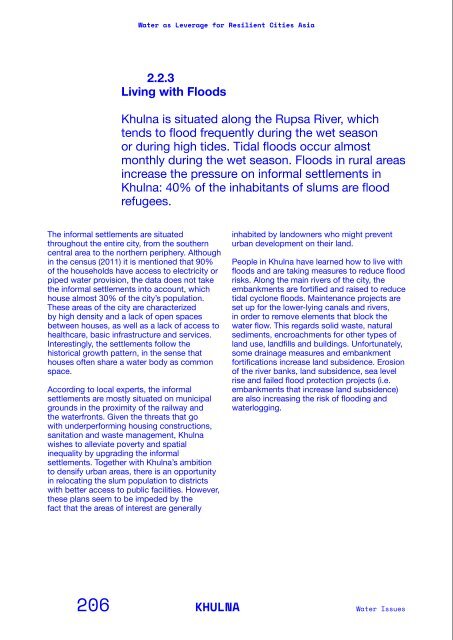Water as Leverage- Setting the scene for a call for action
- No tags were found...
You also want an ePaper? Increase the reach of your titles
YUMPU automatically turns print PDFs into web optimized ePapers that Google loves.
<strong>Water</strong> <strong>as</strong> <strong>Leverage</strong> <strong>for</strong> Resilient Cities Asia <strong>Setting</strong> <strong>the</strong> Scene <strong>for</strong> a Call <strong>for</strong> Action Content<br />
2.2.3<br />
Living with Floods<br />
Khulna is situated along <strong>the</strong> Rupsa River, which<br />
tends to flood frequently during <strong>the</strong> wet se<strong>as</strong>on<br />
or during high tides. Tidal floods occur almost<br />
monthly during <strong>the</strong> wet se<strong>as</strong>on. Floods in rural are<strong>as</strong><br />
incre<strong>as</strong>e <strong>the</strong> pressure on in<strong>for</strong>mal settlements in<br />
Khulna: 40% of <strong>the</strong> inhabitants of slums are flood<br />
refugees.<br />
Embankment of <strong>the</strong><br />
Rupsha river.<br />
New Public Space<br />
New commercial front<br />
<strong>for</strong> in<strong>for</strong>mal settlement<br />
The in<strong>for</strong>mal settlements are situated<br />
throughout <strong>the</strong> entire city, from <strong>the</strong> sou<strong>the</strong>rn<br />
central area to <strong>the</strong> nor<strong>the</strong>rn periphery. Although<br />
in <strong>the</strong> census (2011) it is mentioned that 90%<br />
of <strong>the</strong> households have access to electricity or<br />
piped water provision, <strong>the</strong> data does not take<br />
<strong>the</strong> in<strong>for</strong>mal settlements into account, which<br />
house almost 30% of <strong>the</strong> city’s population.<br />
These are<strong>as</strong> of <strong>the</strong> city are characterized<br />
by high density and a lack of open spaces<br />
between houses, <strong>as</strong> well <strong>as</strong> a lack of access to<br />
healthcare, b<strong>as</strong>ic infr<strong>as</strong>tructure and services.<br />
Interestingly, <strong>the</strong> settlements follow <strong>the</strong><br />
historical growth pattern, in <strong>the</strong> sense that<br />
houses often share a water body <strong>as</strong> common<br />
space.<br />
According to local experts, <strong>the</strong> in<strong>for</strong>mal<br />
settlements are mostly situated on municipal<br />
grounds in <strong>the</strong> proximity of <strong>the</strong> railway and<br />
<strong>the</strong> waterfronts. Given <strong>the</strong> threats that go<br />
with underper<strong>for</strong>ming housing constructions,<br />
sanitation and w<strong>as</strong>te management, Khulna<br />
wishes to alleviate poverty and spatial<br />
inequality by upgrading <strong>the</strong> in<strong>for</strong>mal<br />
settlements. Toge<strong>the</strong>r with Khulna’s ambition<br />
to densify urban are<strong>as</strong>, <strong>the</strong>re is an opportunity<br />
in relocating <strong>the</strong> slum population to districts<br />
with better access to public facilities. However,<br />
<strong>the</strong>se plans seem to be impeded by <strong>the</strong><br />
fact that <strong>the</strong> are<strong>as</strong> of interest are generally<br />
inhabited by landowners who might prevent<br />
urban development on <strong>the</strong>ir land.<br />
People in Khulna have learned how to live with<br />
floods and are taking me<strong>as</strong>ures to reduce flood<br />
risks. Along <strong>the</strong> main rivers of <strong>the</strong> city, <strong>the</strong><br />
embankments are <strong>for</strong>tified and raised to reduce<br />
tidal cyclone floods. Maintenance projects are<br />
set up <strong>for</strong> <strong>the</strong> lower-lying canals and rivers,<br />
in order to remove elements that block <strong>the</strong><br />
water flow. This regards solid w<strong>as</strong>te, natural<br />
sediments, encroachments <strong>for</strong> o<strong>the</strong>r types of<br />
land use, landfills and buildings. Un<strong>for</strong>tunately,<br />
some drainage me<strong>as</strong>ures and embankment<br />
<strong>for</strong>tifications incre<strong>as</strong>e land subsidence. Erosion<br />
of <strong>the</strong> river banks, land subsidence, sea level<br />
rise and failed flood protection projects (i.e.<br />
embankments that incre<strong>as</strong>e land subsidence)<br />
are also incre<strong>as</strong>ing <strong>the</strong> risk of flooding and<br />
waterlogging.<br />
Rain <strong>Water</strong> Discharge<br />
Elevated embankment<br />
Land subsidence<br />
<strong>Water</strong> logging<br />
In<strong>for</strong>mal settlements by <strong>the</strong> waterfront.<br />
206 KHULNA<br />
<strong>Water</strong> Issues<br />
PART 2/Background In<strong>for</strong>mation on <strong>the</strong> Partner Cities<br />
207


















